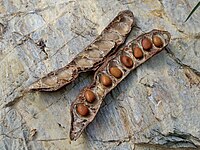
Photo from wikipedia
Abstract Following a request from European Commission, the EFSA Panel on Food Additives and Nutrient Sources added to Food (ANS) provides a scientific opinion re‐evaluating the safety of locust bean… Click to show full abstract
Abstract Following a request from European Commission, the EFSA Panel on Food Additives and Nutrient Sources added to Food (ANS) provides a scientific opinion re‐evaluating the safety of locust bean gum (E 410) as a food additive. Locust bean gum (E 410) is an authorised food additive in the EU. Locust bean gum (E 410) as specified in the Commission Regulation (EU) No 231/2012 is derived from the ground endosperm of the seeds of the strains of carob tree, Ceratonia siliqua (L.) Taub. (Family Leguminosae). An acceptable daily intake (ADI) ‘not specified’ was allocated by the Joint Food and Agriculture Organization/World Health Organization Expert Committee on Food Additives (JECFA) in 1981. Although not evaluated by the Scientific Committee for Food (SCF), it was accepted by the SCF in 1991 for use in weaning food, and in 1994, in infant formulae for special medical purposes. Locust bean gum is practically undigested, not absorbed intact, but significantly fermented by enteric bacteria in humans. No adverse effects were reported in 90‐day toxicity and carcinogenicity studies in rodents at the highest doses tested and there was no concern with respect to the genotoxicity and to reproductive and developmental toxicity of locust bean gum (E 410). The Panel concluded that there is no need for a numerical ADI for locust bean gum (E 410), and that there is no safety concern for the general population at the refined exposure assessment for its reported uses as a food additive. However, infants and young children consuming foods for special medical purposes may show a higher susceptibility to gastrointestinal effects of locust bean gum due to their underlying medical condition. The Panel concluded that the available data do not allow an adequate assessment of the safety of locust bean gum (E 410) in these foods for infants and young children.
Journal Title: EFSA Journal
Year Published: 2017
Link to full text (if available)
Share on Social Media: Sign Up to like & get
recommendations!